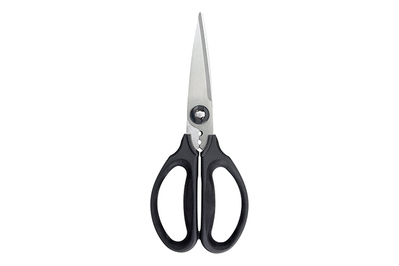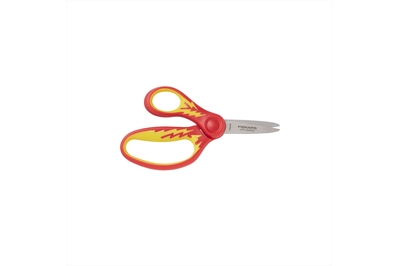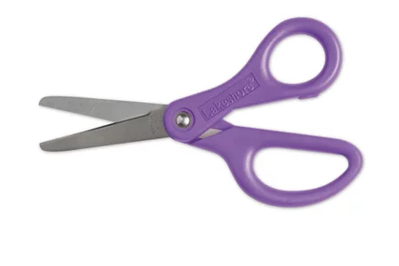
Gabriella DePinho is a writer on the discovery team. She has found cheap(ish) things for medicine cabinets, movie nights, and a good night’s sleep.
Having a single pair of scissors in your home just doesn’t cut it.
If using the same scissors to snip through gift wrap, cardboard boxes, chicken bones, and hair works for you, we’re not going to stop you. But we promise you there is a better way.
Though scissors are simple in design, the world of shears is quite nuanced. If you’re doing dedicated tasks like crafting or cooking, you need a tool that’s sharp, comfortable to grip, and made for the job.
We’ve clipped, sliced, trimmed, and researched our way to the best scissors for each job, so you’ll never have to saw through a cardboard box with dull, wobbly scissors again.
Advertisement
SKIP ADVERTISEMENTThe best scissors overall
For opening plastic packaging, cutting paper, and more, a standard pair of sharp scissors is the perfect multitasker. Writer Meg Muckenhoupt tested over 20 pairs for Wirecutter in 2017 by cutting through paper, cardboard, duct tape, cable ties, denim, and more. Fiskars’s The Original Orange-Handled Scissors (8-inch) managed all of it deftly.
Our pick
The classic orange-handled scissors cut paper and fabric with ease in our tests. The ergonomically designed handles are comfortable to hold, and the scissors come with a lifetime warranty.
The same scissors, with an ergonomic design for left-handed people. They come with a red handle instead of the classic orange.
Buying Options
In all common cutting tasks, the Fiskars Original Orange-Handled Scissors performed extremely well. In our recent follow-up tests, we cut through paper, cardboard, plastic packaging, and more with ease, and the blades provided a clean, precise cut. The large, ergonomic handles allowed for a comfortable grip and easy control of your motion. (Don’t worry, southpaws, they come in a left-handed version as well.)
The original Fiskars scissors have an adjustable pivot screw that can be tightened if they get loose or removed to pull apart the blades for sharpening. (Fiskars sells a sharpener for its scissors, which we didn’t test, but many crafts stores and cutlery shops provide tool sharpening as well). The stainless steel blades on the original Fiskars scissors are a bit softer than some other scissors we tested, and they might need sharpening more frequently than shears made from hardened stainless or forged steel. But taking a few minutes to sharpen the blades every so often is worth it for the great value.
All Fiskars scissors come with a lifetime warranty, which covers defects in materials and workmanship when purchased from Fiskars or an authorized Fiskars seller, but it does not include sharpening.
The best fabric and sewing scissors
A good fabric scissor is designed to deliver precise, clean cuts that don’t fray or damage your fabrics. That means thick, long blades set extremely close together to create tension that helps keep your fabric steady as you cut. The flat bottom blade allows the shears to lay flat against the table as you cut through the fabric.
With that being said, our staff sewists think our overall top-pick scissors, the Fiskars Original Orange-Handled Scissors, are also the best choice for an entry-level fabric scissor.
Note that if you opt to use the original Fiskars scissors for both general cutting and fabrics, you should buy two pairs and label one “for fabric only” so the blades stay crisp and unblemished.
“For a nice intro pair of scissors, I don’t really think you can beat Fiskars,” said updates writer Abigail Bailey, who worked as a sales associate at the cut counter of a fabric and craft store for a year and has been quilting for several years. Abigail saw customers gravitate toward cheaper, generic-brand scissors, but she believes that the original Fiskars scissors are well made and worth the few extra dollars.
Wirecutter’s quilt and textile expert, senior staff writer Jackie Reeve, also relies on Fiskars scissors for her fabric work. She’s had the same pair for nearly 20 years and has kept them in good shape by sharpening them and making sure they’re used carefully.
However, if you’re looking for a nice gift for a sewist, the Gingher Knife Edge Dressmaker’s Shears (8-inch) are made with forged steel and have a flat bottom blade for steady cutting. The rounded handle is comfortable to hold and can be used ambidextrously. Abigail has had a pair of these sturdy shears for three years.
For the sewist looking for a specialty scissor, these forged-steel shears have a flat blade for steady cutting, are comfortable to hold, and come with a lifetime warranty.
Buying Options
“They cut through fabric like butter,” Abigail said of her Gingher scissors. “It is so smooth. It’s like you’re not cutting through anything, it just goes.”
For consistent quilters and other experienced cutting crafters, Jackie recommends a switch to rotary cutters and a self-healing cutting mat. She uses Olfa rotary cutters, which she said is the brand she sees “mentioned the most among quilters.”
Rotary cutters are much faster to use and allow for quick, clean cuts through large pieces of fabric. The blades are sharp and can be changed out, so Jackie extends the life of her blades by using the sharpest, newest blades on her fabric and saving dull blades for cutting out paper patterns.
We recommend adding these snips to your crafting essentials kit in our guide to the best fiber craft kits.
Buying Options
Kase Wickman, the author of our fiber craft kits guide, recommends the Deein Sewing Scissors (4.1-inch) as a supplemental item that can improve your crafting experience. They have sharp, pointy blades made with high-carbon steel and an easy-to-hold, squeezable handle. Storing a pair with your craft materials means you don’t have to hunt down your full-size scissors each time you need to snip some thread or yarn—just be careful to store them safely.
Advertisement
SKIP ADVERTISEMENTThe best kitchen shears
For sanitary and safety reasons, it’s a good idea to have dedicated kitchen shears for cutting food and its packaging.
Kitchen shears are fundamentally different from regular scissors, because they’re designed for slippery, thick foods. The blades’ pivot point, also known as the fulcrum, is far from the handles, which gives you greater leverage to apply force when they’re cutting through particularly tough materials.
Additionally, kitchen shears need to have blades that can be taken apart for easy and frequent cleaning, as particles of meat and other residue can harbor bacteria.
Meg, who wrote a previous version of this guide, tested 16 pairs of kitchen shears in 2017 by snipping chives, marshmallows, green beans, and more, as well as cutting a whole chicken into parts.
The OXO Good Grips Kitchen and Herb Scissors (8.75-inch) came out on top in our tests then and are still the pair of kitchen shears we reach for in our test kitchen.
Our pick
One micro-serrated blade helps these scissors grip raw chicken while the other blade makes a clean slice—something that can’t be said of the competition in this category. The blades can be pulled apart for easy and thorough cleaning.
The OXO kitchen scissors feature sharp, stainless steel, micro-serrated blades for gripping slippery raw meats, and the blades come apart for easy cleaning. They have roomy, slightly cushioned handles, and OXO’s satisfaction guarantee gave these a leg up on shears that performed similarly.
As a nice additional feature, small divots in the metal above the pivot screw come together to work as an herb stripper, quickly removing fresh herbs from their tough stems.
Ciara Murray Jordan, an associate staff writer on the kitchen team, has had a pair of the OXO kitchen scissors for six years and says hers are still in great shape, even with frequent use. She uses them for everything—cutting bacon right into the pan, snipping last-minute scallion garnishes, and slicing pizza, for example—so she can avoid unnecessarily dirtying a cutting board.
We recommend hand-washing the OXO kitchen scissors since they are not dishwasher-safe, but the micro-serrations can make them a bit trickier and more time-consuming to clean.
The best kids safety scissors
In a home with young children, having effective but safe kids scissors on hand is of the utmost importance—how else are they going to make valentines, snowflakes, and pumpkins out of construction paper?
We consulted several elementary school teachers to see what scissors they have in their classrooms, then had two dozen kids ranging in age from 4 to 11 test them in our office, making paper crafts and a bit of a confetti mess.
While blunt-tip scissors can be safer, it’s important to ensure your little ones know proper scissor safety. You should always keep a close eye on children as they use scissors to make sure no one gets hurt—or gives themselves a spontaneous haircut.
After hours of crafting and cutting, our Wirecutter kiddos found two favorite pairs of safety scissors, with a noticeable divide in age.
Fiskars Softgrip Blunt-Tip Kids Scissors (5-inch)
Safety scissors for pre-K and kindergarten-age children
Our littlest kids liked the soft grip and found that cutting was satisfactory with these.
Fiskars Softgrip Left-Handed Pointed-Tip Kids Scissors (5-inch)
Safety scissors for pre-K and kindergarten-age children
Left-handed kids scissors with the same soft grip but with a pointed tip instead.
Buying Options
Testers age 5 and under liked the way the Fiskars Softgrip Blunt-Tip Kids Scissors (5-inch) felt in their hands. They all said that the Fiskars kid scissors cut well but provided noticeable resistance when they were opening and closing the scissors in a cutting motion. When cutting a piece of paper that was folded multiple times over to make, say, a snowflake, they found the Fiskars kid scissors required a little more effort to cut with but still succeeded in completing the task.
However, the large finger loops and soft silicone grips made them easier and more comfortable to hold and cut with for longer. These should work for right- and left-handed children, but the Fiskars kid scissors are also available in a version just for lefties that comes with a pointed tip.
These scissors were clear favorites among our testers for their smooth cutting ability.
Buying Options
Our older testers, ages 6 to 11, all favored the Lakeshore Best-Buy Blunt-Tip Scissors (5-inch) for their smooth cutting ability. While some older children felt like the handles were a little small, they all liked that the hinge on the scissors felt loose, which made cutting all kinds of shapes through a single sheet or a folded paper quite easy. These scissors worked well for right- and left-handed kids, and they were comfortable to hold.
We dismissed the School Smart Pointed Tip Kid Scissors because our testers found the soft overmold grips less comfortable to hold than the grip on the Fiskars kid scissors, and the cutting performance was just okay compared with both the Fiskars and Lakeshore options.
Advertisement
SKIP ADVERTISEMENTThe best travel scissors
You never know when a flyaway thread might pop up, or if you’ll feel inspired to get crafty while on the go, so having a pair of travel scissors comes in handy. If your travels will take you through airport security, then your typical pair of scissors shouldn’t be in your carry-on.
TSA-compliant scissors must be less than 4 inches from the pivot point. You can take a larger pair with you in a checked bag, but they must be securely wrapped—and if you want to have access to your scissors in-flight, you’ll be out of luck.
After testing three TSA-compliant options, we recommend the Coghlan’s Folding Scissors (3.15-inch) as the best travel-friendly scissors.
Our pick
Sharp stainless steel scissors come with a one-year limited warranty and are TSA-compliant.
Buying Options
In testing, deputy editor Annemarie Conte found the Coghlan’s scissors provided a nice balance of quality and ease of use. They are comfortable to hold, made of stainless steel, fold up quickly, and are perfect to keep in a travel kit for a variety of uses, especially making friendship bracelets on the go. They’re good for ambidextrous use and come with a one-year limited warranty.
The best hair scissors and snips
In an instance of “spend a little, save a lot,” committing to cutting your hair at home can help you save on increasing salon fees. If you’re managing a short cut, hair clippers work just fine. For longer lengths or textured styles, you need to venture into hair scissors. While it might take a little trial and error to figure out exactly how to cut your own hair, having the right snips can help you get the job done right.
These expert-recommended hair shears can do the trick, regardless of hair type.
Patty Mocarski, stylist and owner of New York City’s Little Space Salon, recommends the JW Shears Craft X Series Shear (5.5-inch) for trimming bangs and snipping off split ends in our guide. Though we haven’t tested them, these shears feature sharp blades and a comfortable design—with a built-in finger rest—and they come with a lifetime warranty.
You can use these expert-recommended nail scissors to trim your bangs.
Buying Options
Mocarski also recommended the Erbe Matte Finish Inox Stainless Steel Nail Scissors for beginner home hairstylists looking to maintain their bangs. Opting for nail scissors over traditional hair shears for a home cut can prevent you from cutting off too much hair at once, since the snips have smaller blades. These are made from stainless steel and come with a lifetime warranty. (You’re welcome to also use these for your nails, but we recommend reaching for nail clippers instead.)
Advertisement
SKIP ADVERTISEMENTWhat about shop shears?
While some crafters use threads, needles, and yarn for their projects, others have workbenches cluttered with power tools, sanding paper, and wood scraps for theirs. And if you’re one of these workbench-oriented folks, you have plenty of snipping and shaping to do, but your tool needs are different.
Our staff tool experts say that you don’t need a particular pair of shop shears or scissors for your workbenches. Instead, they agree that a utility knife is a more versatile addition to your toolbox.
“Most of the time it’s not a job for scissors, it’s a job for a utility knife,” said senior staff writer Doug Mahoney, who wrote our utility knife guide.
Utility knives can be used for a wide range of jobs like breaking down cardboard boxes, slicing the painted seam on a stuck window, or cutting materials like drywall, carpeting, rope, and roofing shingles. Our top pick, the Milwaukee 48-22-1502 Fastback Utility Knife with Blade Storage, won us over for its ergonomics and safety features.
A multi-tool that has mini scissors is a good tool to keep in your pocket, but you’ll probably be using them only for quick snips and fixes while on the go. If you have bigger projects in the works, you might need to upgrade to more-specific tools like aviation snips, pruners, or—of course—wire cutters.
A previous version of this article was written by Meg Muckenhoupt. This article was edited by Annemarie Conte and Catherine Kast.
Advertisement
SKIP ADVERTISEMENT











